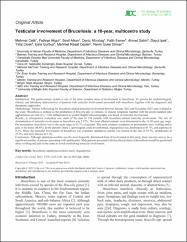Testicular involvement of Brucellosis: A 10-year, multicentre study
Citation
Celik M, Akgul F, Alkan S, Altındag D, Esmer F, Sahin A, Ipek D, Cicek Y, Gurbuz E, Ceylan MR, Guler Dincer N (2023) Testicular involvement of Brucellosis: A 10-year, multicentre study. J Infect Dev Ctries 17:1285–1291. doi: 10.3855/jidc.18084Abstract
Introduction: The genito-urinary system is one of the most common areas of involvement in brucellosis. To present the epidemiological, clinical, and laboratory characteristics of patients with testicular involvement associated with brucellosis, together with the diagnostic and therapeutic approaches.
Methodology: Patients followed up for brucellosis-related testicular involvement between January 2012 and November 2022 were included in the study. Brucellosis is defined as the production of Brucella spp. in cultures, or clinical symptoms together with the serum standard tube agglutination test titer of ≥ 1/160. Inflammation in scrotal Doppler ultrasonography was based on testicular involvement.
Results: A retrospective evaluation was made of the data of 194 patients with brucellosis-related testicular involvement. The rate of determination of testicular involvement in brucellosis was 2.57%. The most affected patients were determined in the 16-30 years age range. On presentation, brucellosis was in the acute stage in 83.7% of patients. The most common symptoms on presentation were swelling and/or pain in the testes (86.6%). In the patients where a spermiogram could be performed, oligospermia was determined in 41.7%, and aspermia in 8.3%. When the testicular involvement of brucellosis was evaluated, epididymo-orchitis was present at the rate of 55.7%, epididymitis at 27.3%, and testis abscess at 5.1%.
Conclusions: Although epididymo-orchitis was the most frequently determined form of involvement in this study, there was also seen to be a significant number of patients presenting with epididymitis. Male patients presented with the clinical status of brucellosis should be questioned about swelling and pain in the testes to avoid overlooking testicular involvement.


















